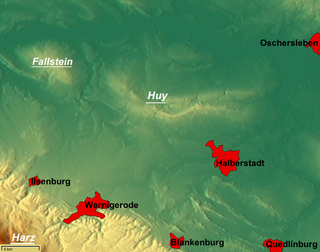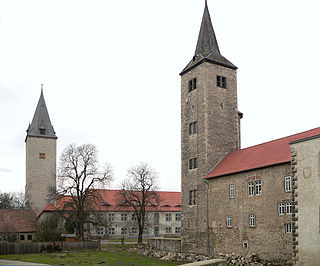
The Harz is a Mittelgebirge that has the highest elevations in Northern Germany and its rugged terrain extends across parts of Lower Saxony, Saxony-Anhalt, and Thuringia. The name Harz derives from the Middle High German word Hardt or Hart, Latinized as Hercynia. The Brocken is the highest summit in the Harz with an elevation of 1,141.1 metres (3,744 ft) above sea level. The Wurmberg is the highest peak located entirely within the state of Lower Saxony.
Goslar is a district in Lower Saxony, Germany. It is bounded by the districts of Göttingen, Northeim, Hildesheim and Wolfenbüttel, the city of Salzgitter, and by the states of Saxony-Anhalt and Thuringia (Nordhausen).

Harz National Park is a nature reserve in the German federal states of Lower Saxony and Saxony-Anhalt. It comprises portions of the western Harz mountain range, extending from Herzberg and Bad Lauterberg at the southern edge to Bad Harzburg and Ilsenburg on the northern slopes. 95 % of the area is covered with forests, mainly with spruce and beech woods, including several bogs, granite rocks and creeks. The park is part of the Natura 2000 network of the European Union.

Clausthal-Zellerfeld is a town in Lower Saxony, Germany. It is located in the southwestern part of the Harz mountains. Its population is approximately 15,000. The City is the location of the Clausthal University of Technology. The health resort is located in the Upper Harz at an altitude between 390 and 821 m above sea level.

Osterode am Harz often simply called Osterode, is a town in south-eastern Niedersachsen on the south-western edge of the Harz mountains. It was the seat of government of the district of Osterode. Osterode is located on the German Timber-Frame Road.
Osterwieck-Fallstein was a Verwaltungsgemeinschaft in the district of Harz, in Saxony-Anhalt, Germany. It was situated north of the Harz, and north of Wernigerode. The seat of the Verwaltungsgemeinschaft was in Osterwieck. It was disbanded on 1 January 2010.

Osterwieck is a historic town in the Harz district, in the German state of Saxony-Anhalt.
Harz is a district in Saxony-Anhalt, Germany.

Bundesstraße 27 or B27 is a German federal road. It connects Blankenburg am Harz with Rafz in Switzerland.

The Harzer Wandernadel is a system of hiking awards in the Harz mountains in central Germany. The hiker can earn awards at different levels of challenge by walking to the various checkpoints in the network and stamping his or her passbook to record the visit. With 222 checkpoints in three federal states and across five districts in the Harz and with membership in five figures, the system has gained a following Germany-wide.

The B 242 is a federal highway in Germany. It runs from Seesen to Mansfeld.

The Upper Harz refers to the northwestern and higher part of the Harz mountain range in Germany. The exact boundaries of this geographical region may be defined differently depending on the context. In its traditional sense, the term Upper Harz covers the area of the seven historical mining towns (Bergstädte) - Clausthal, Zellerfeld, Andreasberg, Altenau, Lautenthal, Wildemann and Grund - in the present-day German federal state of Lower Saxony. Orographically, it comprises the Harz catchment areas of the Söse, Innerste and Grane, Oker and Abzucht mountain streams, all part of the larger Weser watershed.

The Upper Harz Water Regale is a system of dams, reservoirs, ditches and other structures, much of which was built from the 16th to 19th centuries to divert and store the water that drove the water wheels of the mines in the Upper Harz region of Germany. The term regale, here, refers to the granting of royal privileges or rights in this case to permit the use of water for mining operations in the Harz mountains of Germany.

Hessen, also Hessen am Fallstein, is a village in the Harz district of Saxony-Anhalt, Germany. Formerly part of the Aue-Fallstein municipal association, it was merged into the Osterwieck municipality on 1 January 2010.

The Großer Fallstein is a wooded hill region in the German state of Saxony-Anhalt. It lies in the district of Harz on the territory of the town of Osterwieck, north of the Harz Mountains. Its highest point has an elevation of 288 metres above sea level (NN).

Hoppenstedt is a village in the municipality of Osterwieck in the northern Harz Foreland, Germany. The town Osterwieck lies about 4.5 kilometres to the southeast and the Lower Saxon state border is about 3 kilometres away.
Paul Francke was a German Renaissance architect, most notable as director of works for the Duchy of Brunswick-Lüneburg from 1564 until his death in 1615. His works include the Juleum Novum in Helmstedt, the Marienkirche in Wolfenbüttel and the Burganlage in Erichsburg.

Schloss Hessen is a schloss or castle in Hessen, Saxony-Anhalt, Germany. It originated as medieval moated castle before being converted into a Renaissance princely palace in the 16th century. Its heyday was as the summer residence of the dukes of Brunswick-Lüneburg in the 17th century. It was later used as a farm house.













